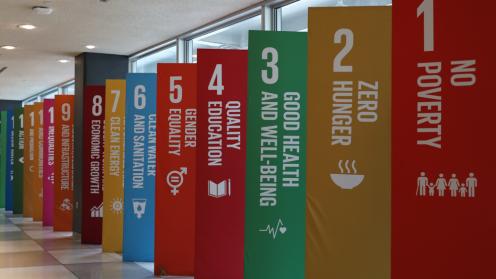The Ministerial Segment of the 2023 session of the High-level Political Forum on Sustainable Development (HLPF) opened with calls for renewed commitment to the 2030 Agenda for Sustainable Development and the 17 Sustainable Development Goals (SDGs), and for countries to bring concrete plans and pledges to the SDG Summit in September 2023. These sentiments were echoed frequently in national statements during the Segment’s general debate that took place through the day.
The sixth day of HLPF 2023 also featured a “fireside chat” with scientists who helped prepare the Global Sustainable Development Report 2023 (GSDR), and, in a parallel session, the presentation and discussion of five second Voluntary National Reviews (VNRs) and one third VNR.
Want to dive deeper? Read the full Earth Negotiations Bulletin daily report.
Calls for Action
In the Ministerial Segment opening, UN Economic and Social Council President Lachezara Stoeva (Bulgaria) encouraged all to stay focused and determined towards a successful 2030 Agenda.
Noting that world hunger has returned to 2005 levels, bridging gender inequality could take 300 years, and nearly 600 million people will still experience extreme poverty in 2030, UN Secretary-General António Guterres called for all nations to come to the SDG Summit with clear plans and pledges. Noting finance is the “fuel” to drive progress on SDGs and that global financial and debt-relief architectures must be urgently reformed, he outlined his SDG Stimulus plan, which calls for unlocking USD 500 billion annually for developing countries.
Csaba Kőrösi, President, UN General Assembly, outlined key elements for spurring transformative change needed to realize the 2030 Agenda, including reducing the negative externalities of SDG investments, and urged participants at the SDG Summit to be “courageous, ambitious and determined” in their promises.
Noting that climate change is a threat multiplier and mitigation and adaptation have more synergies than tradeoffs for the SDGs, Hoesung Lee, Chair, Intergovernmental Panel on Climate Change, suggested that deep greenhouse gas emission cuts may be the best contribution to sustainable development.
Fireside Chat Featuring GSDR Scientists
This session featured a conversation with Imme Scholz and Jaime Miranda, Co-Chairs of the Independent Group of Scientists writing the GSDR. They said the GSDR shows that change processes are not smooth, trade-offs are sometimes necessary across competing goals and targets, and that as new pathways emerge, others must be phased out. They stressed the GSDR is not intended to be prescriptive but rather to provide an analytical framework to accelerate transformative actions at different levels and make the case for knowledge alliances across science, policy and society.
General Debate: Building Momentum Towards the SDG Summit
During the Ministerial Segment’s general debate, all speakers expressed commitment to the 2030 Agenda and the SDGs and most described national and local progress on the SDGs. Many emphasized the need to integrate policies at different scales with the SDGs and renew commitments to the 2030 Agenda.
Delegates emphasized, inter alia, increased and innovative financing to achieve the SDGs, including through reforming the international financial architecture. Several developing countries also urged developed countries to fulfill their past funding commitments, including official development assistance and climate financing.
Voluntary National Reviews
The Democratic Republic of the Congo, Guyana, Romania, the Central African Republic, and Uzbekistan presented their second VNR, with Chile presenting its third report. In addition to highlighting developments since previous reports, the presentations addressed efforts to accelerate recovery from the COVID-19 pandemic while strengthening resilience to new crises. Presenters also responded to questions from observers on specific strategies adopted as well as insights from the VNR preparation process, and broader experienced and expected challenges.
To receive free coverage of global environmental events delivered to your inbox, subscribe to the ENB Update newsletter.
All ENB photos are free to use with attribution. For HLPF 2023, please use: Photo by IISD/ENB | Kiara Worth.
Opening of the High-level Segment of ECOSOC / Ministerial Segment of the HLPF

Delegates gather in the General Assembly Hall for the opening of the high-level/ministerial segment of HLPF

Jevanic Henry, UN Secretary-General Youth Advisory Group on Climate Change, and Asma Rouabhia, Global Focal Point, SDG 7 Youth Constituency

Salvatore Aricò, CEO, International Science Council, moderated a fireside chat with scientists from the GSDR

Panel speakers during the fireside chat: Co-Chairs of the Independent Group of Scientists writing the GSDR Imme Scholz, Co-President, Heinrich Böll Foundation; Jaime Miranda, Head of Sydney School of Public Health, University of Sydney, Australia; and Marilynn Holguín Clover, Youth Delegate, The Millennials Movement
General Debate: Building Momentum Towards the SDG Summit

Alejandro Gil Fernández, Deputy Prime Minister and Minister of Economy and Planning, Cuba, on behalf of the G-77/China

Suharso Monoarfa, Minister of Development Planning and Chairman of the National Development Planning Agency, Indonesia, on behalf of Mexico, Indonesia, South Korea, Turkey, and Australia (MIKTA)

Péter Szijjártó, Minister of Foreign Affairs and Trade, Hungary, on behalf of the Partnership for Regional and Interregional Cooperation for Sustainable Development

Kabo Sechele Morwaeng, Minister for Presidential Affairs, Governance and Public Administration, Botswana, on behalf of the Group of Landlocked Developing Countries (LLDCs)

Fatumanava-o-Upolu III Dr Pa’olelei Luteru, Permanent Representative of Samoa to the UN, on behalf of the Alliance of Small Island States (AOSIS)

Marlon Navarro, Vice-Minister of Planning and Economic Policy, Costa Rica, on behalf of the Justice Action Coalition

Min Bahadur Shrestha, Vice-Chairman of the National Planning Commission, Nepal, on behalf of Least Developed Countries (LDCs)






































